I love whitework embroidery. I love vintage and antique linens.
And, in my mind, the perfect marriage of both of these can be found in delicate whitework handkerchiefs of old.
And so, now and then, I’ll pick one up from antique dealers, estate auctions, and the like.
I’m not an avid collector. But, occasionally, I will treat myself to a vintage or antique embroidered handkerchief if there is something about it that appeals to me, if there’s something I can learn from it, and if the price is reasonable.
This particular handkerchief that I’m going to show you today fell into all of the above categories – I like the design, I can learn something from it, and since I was the only person bidding on it, it was reasonably priced.
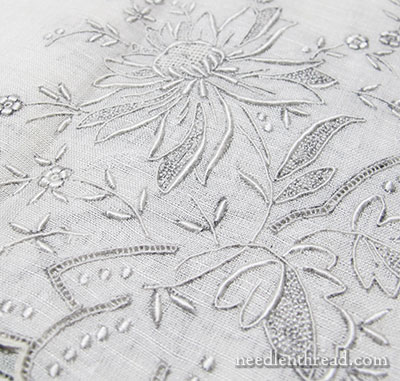
The handkerchief is embroidered on all sides and all four corners in a floral and leaf design. It features some very tiny openwork areas, padded satin stitching, some seed stitching, and a buttonholed, scalloped edge.
You can see the inking marks from the design placement on the handkerchief. It makes the piece somewhat Appenzell-embroidery-ish (Appenzell-like embroidery), but I won’t go as far to say it is authentic Appenzell embroidery, because I don’t know the provenance of it.
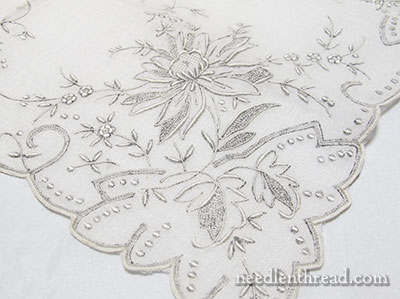
In any case, this particular piece is pretty. But I think it would be prettier without the pattern marking – or at least, with a much more faded marking that looks more silver or grey than black.
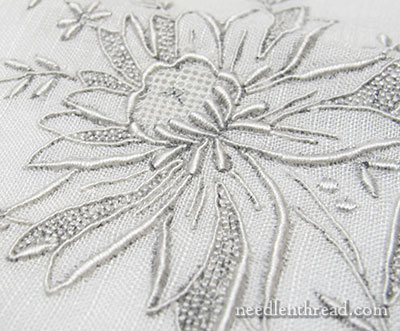
You can see that the center of the main flower is worked in an open work grid – but I’m surprised to see the pattern marking in the middle of the grid. On each flower on each corner of the hanky, there’s a mark like this in the middle of the grid work.
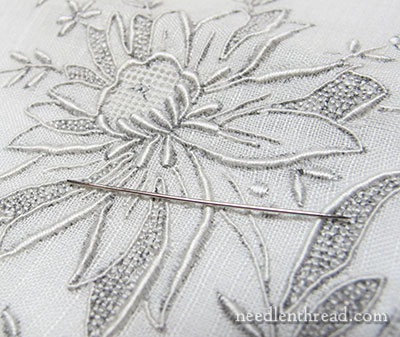
Just to give you an idea of the actual delicacy of the piece, I placed a #10 crewel needle on handkerchief. Now, in the photo, the needle looks big – but if you know needles, you know that a #10 crewel needle is a fine, small needle.
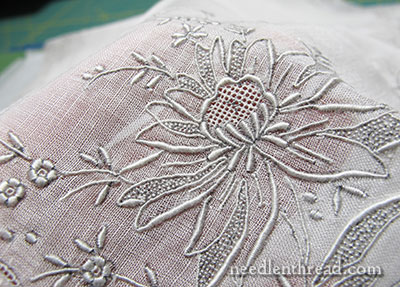
The linen is quite sheer. That’s my hand behind it.
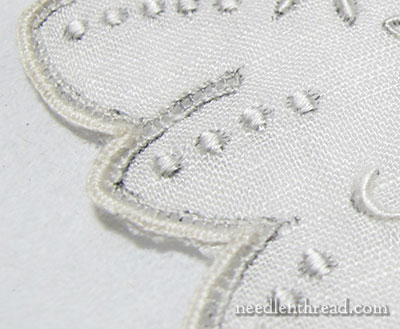
The edge has a tiny openwork border and is buttonholed very neatly all around, but the clean-up work around the buttonholed edge is rather messy.
So, I’m thinking this piece is kind of a knock-off of Appenzell embroidery, probably made for the tourist industry.
Regardless, I think it’s a beautiful hanky. But I’d rather see it without the black – or at least, with the black pattern markings faded to the softer grey more typical of Appenzell embroidery. The sharp black – and the messy clean up around the edges – makes me think that the finisher wasn’t too diligent.
In any case, I’m going to clean it up a bit myself. Though not new, the handkerchief is in pristine condition – there are no holes, no stains, not age spots. It’s in very good shape.
I’m going to do something to the hanky – but I’m not going to say what, yet. I’ll do it and we can look at the results together. If I make a huge mistake and ruin the handkerchief, you can cry with me, berate me, or run me out of town on a rail. If what I’m planning works out (and I think it will), then you won’t need to break out the tar and feathers just yet.
I’ll report back later on with the results!
Any input? Any thoughts on the handkerchief in general? Any musings or wonderings about these types of antique linens? Any stories about terrific vintage embroidery finds (I love stories like that!)? Feel free to chat it up below!







Good Morning Mary,
Mmmm..what a sheer lovely hanky! Such fine tiny stitches to study and savor. Would floche be the thread used in Appenzell embroidery?
The hanky seems to have a beautiful sheen (in your photos) which is characteristic of floche. Thanks. Roxanne
I find my heart racing a bit reading this and viewing the pictures of that gorgeous hanky. My desire to learn the skill to make such beautiful things is almost overwhelming. But I must work, work, work for silly lawyers. Looking forward to the weekend 😉 Thank you for sharing your expertise and knowledge.
I tend to search the linen bins in thrift and antique stores for treasures, some of which I have rescued for $5.00 or less. I do find that I have a more discerning eye than I once had, but over time I have accumulated some very fine pieces of whitework, some monogrammed, and some trimmed with hand-made lace. Unfortunately, sometimes that linen may be discolored, or have a small hole, but I don’t seem to mind.
Oh how pretty I must learn how to take pictures for the computer, i am not so good i would love to show you same of my Mothers work she work and learnt from a jews man and lady from German in the 2 World war I still haave a lot of heeer work under lock and key I must get a friend to help me so i can show you
REGARDS
Dennis
For really bad stains on things, I use an oxi-type carpet stain remover. For just regular whitening I use a powdered oxi-type of clothing stain remover and soak the item in it. I try to determine if it is a body based stain like sweat or blood, or if it is a grease based stain like oil or lipstick. If it’s body based, I start with hand soap, or shampoo. If it’s grease based I go for dawn dish washing liquid. If those don’t work, on to the oxi-type of powdered stain remover for a good, long soak.
i would like to know how you will take it out. I have a tablecloth that has a blue tint on it. It doesn’t seem to come out in hand washing. thanks in advance
You should be able to use Biz and let soak to remove the marking. It may take repeated soaking to remove it. Lemon and sunlight may also remove the marking.
Oh I do love this piece. I’m not very knowledgeable about embroidery but I love anything done in white.
I did purchase a beautiful hankie one time and had it framed like a picture. Just a suggestion for what you could do with that pretty little one you have.
Eva
Yes, framing them is a great idea! I also like to use mine like doilies, under a pretty vase or statue, if the inside is blank.
Hi Mary
I too collect old handkerchiefs – mostly from family and friends but I have purchased a few as well. I have a couple of this type of embroidery – thanks for identifying and commenting on the style – I knew it was something special as they had always appealed to me.
I have some projects which use the hankies rather than having them sit ini the drawers, but there are some I just can’t cut up and just keep for looking at.
Beth
come on mary whatcha gonna do with that hanky?
i’ll bet you’re going to put an iron on backing on it. aren’t you? this will make everything stand out better and also protect it? and if it doesn’t work or ruins it……….oh well can’t blame a girl for trying.
am I right, mary? come on, tell me.
Lyn Procopio
Dear Mary
I do like this kind of embroidery whether whitework or appenzell the floral design on the handkerchief is lovely, it must have taken a long time to embroider all four sides of the hanky. One of these days I will definitely try whitework which is on my to do list. I wonder how you will clean it up and will you remove the black marks completely or to a faded grey. I will look forward to the results on the clean up which I hope will be a success. Thanks for showing us your antique hanky and the lovely embroidered floral design.
Regards Anita Simmance
I remember when you could still purchase hankies like that in the store. Most of them were made in The Phillippines or China. We just washed and ironed them because they were meant to be used. This was in the pre Kleenex days when everyone carried a handkerchief.
I lived in the Philippines for a year and these types of hankies were common there, but almost all of them were made for export. The local people only kept the factory rejects. An odd fact, some of the very sheer organza-looking hankies are made out of fabrics from pineapple and banana fibers. I have a couple of them, and yes they have those black pencil marks as well.
I’m sure that somewhere in this encyclopedia you’ve written there are discussions of how to safely clean antique linens, so I’d appreciate it if you could point me in the right direction. I’d like to know more about safe ways to reduce the yellowing without damaging the fibres.
I’m tempted not to add that it shamefully is one of my own UFOs that needs the help, but I must confess that it is. 🙁
Try Orvis – it’s a good cleaner – but make sure that none of the colors are capable of running first!
For whitework, there’s also a product called “restoration” that works pretty well. But don’t use it with colors! They’ll fade!
Thanks for the tip, Mary! Orvus detergent is used for quilts too, I should have remembered that one. 🙂
G’day Mary, I love it, and all old embroidered household linen and personal items.Taring and feathering is a bit drastic. How about just dunking and ortting, as in thread off cuts. Very interested to find out your ‘something’. Reckon, whatever the go, it will be absorbing!
Thank you, Cheers, Kath.
Dear Mary,
I know that you can find quite easily these type of handkerchiefs on the Chinese market. They are made in Honk Kong by orphan. They work hard, they do not get any salary. They have food and bed. They are allowed to make their own dowry. They are very young and have very good eyes. Their embroideries are beautiful and very cheap for our market. I was given by a lady some handkerchiefs like yours and some beautiful appliqués as well.
I believe what you may have here originated in China. They have some fabulous embroidery of this type, but you always see the pattern outline in the finished work. I lived in China for a couple of years and you could buy this type of fine embroidery at most tourist shops, and many pieces were more elaborate than this one. The work is always very fine, but that gray pattern outline is rarely removed before the piece is sold.
Yes, I would imagine this is made for the tourist market, and probably in China or the Phillippines, like Carolyn mentioned. The visible outline, though, is not always a sign.
With the other handkerchiefs from the same estate that I was looking at, this particular one wasn’t as fancy as the others, and the others went for almost $100 each, but I don’t think they’re worth that, because I do suspect they are knock-offs made for the tourist market. In fact, there’s one on sale online right now that’s quite similar – a little more intricate, almost exactly like the ones that sold for around $100 in the same auction, and this other one is priced around $300-$400, which is nuts. If it were real Appenzell from Switzerland, I could see a price like that, but I suspect it isn’t.
For this one, I was the only bidder, and I got it for around $15. And for $15, I am very happy with it!
I love reading your thoughts – will be interested to see what you ‘do’ with hankie !! I fight with myself when I use old lace and linens – but I often must cut up if I am to reuse but I delay this a lot just to look at the pieces in their original form.
Thanks again for all the directions you send me – especially loved playing (on your prompting) with coronation cord. I find I am using the half I ‘whitened’ more than the original antique cream shade – a little sad about that!
Lovely! The overal effect anyway.
I am busy with a whitework hanky at the moment – Mary Suarez’s ‘Les colombes’, and I am looking forward to make a hanky for each of my daughters and grand-daughters, complete with monograms. But I don’t want to make the same designs, so I need to come up with at least 3 designs, the grand-kids could have the same as an aunt, without a problem. That leaves me with 8 hankies in total:-)
I am itching to see the full design. I wouldn’t mind using it to make my own version.
As for another use, it would look lovely if quilted on a whole-cloth quilt, using it as a centre-piece.
I have collected several antique hankies from EBay to go into my Jane Austen Basket, a project from Gay Ann Rodgers, for my daughter who teaches Jane Austen’s novels. For the most part none have had the problem this one has. Hair spray and Dawn have usually worked to get rid of ink stains but sometimes they can be stubborn. Fluorescent light has faded ink lines out of paper much to my husband’s disgust and currently I have a project under my florescent magnifier to rid a Corolle doll’s arm of ink stains put there by my granddaughter before she new better. Slowly but surely it is working much to my delight.
I look at things like this and sigh. Not because it isn’t beautiful, it is. But because I’ve yet to discover how to stitch so delicately. Sometimes when I look at embroidery I have a little pang in my heart, because as hard as I try my stitches still seem rough and clunky in comparison.
I have a few of these “grey design” hankies in my collection, too. I, also, believe they are of Chinese origin. I haven’t been successful at removing the gray, but haven’t tried too hard. I would be surprised if it would just “soak” out. When I took a madiera embroidery class from Carolyn Walker years ago — she marked the clothes the way they do in Madiera AND she gave us each a sliver of lye-based soap to remove the blue design lies when we were finished. I have also read of using kerosene-based cleaners for removing the old style of embroidery markings. I haven’t tried this. Just throwing the ideas into the ring.
The beauty of the stitching is breath-taking…..hours of work by a skilled embroiderer.
Delight to the eyes.
Grace
This is such a pretty hanky! I collect them, too, and when I saw this article I went to my collection and found three identical hankies similar to this one, with the grey markings on it. So I’ll wait and see what you do with yours, and try it out on mine.
I would recommend Oxy Clean. I have done this on several old pieces I have found. WHITE only!! (Or ecru that might end up turning white). Mine were stained and really not appreciable in the condition I found them. I had no where to go but up. First I just gently wash with a detergent soap. This gets out dirt and dust. Then, when that is not enough, a friend that collects vintage linen will let it soak in an OxyClean ( or vintage cleaner like Restoration) solution – often over days , changing water several times, but never wringing, etc. I am of the more aggressive persuasion, and I must admit some of my items are much more stained. I get a big pot of water boiling. Important-**** do not put dry item into boiling water and never do this on the stove!!! Now have a large (I like stainless steel) pot inside the sink. Have OxyClean in this pot. Pour boiling water and stir. It suds way up and often overflows. This is why you never, never do it on the stove, as it could ruin the finish. Take wet item, or items, and with a wooden spoon stir push gently into to very, very hot mixture. Let soak. You might need to push all edges gently down into the mixture – or could use a china plate to keep items submerged. Let it stay in that pot until the water has grown cold. Now gently rinse, multiple times, with cold water. Could refill pot many times until clear. I am always amazed at how often all spots, rust marks, blood, disappear. It really works. Remember they use to boil their clothes. I have boiled in the above solution, making sure it doesn’t overflow. But that is rare and only when I thought the item would be tossed. Less aggressive usually works well. Good luck!
I’m all for boiling linen – I do it often! Well, I pour it on from the kettle…..
How did the seamstress make such tiny holes without the delicate fabric fraying?
Possibly a learning piece for a young woman that really didn’t like
needlework?
Whitework must be the ice maiden of all embroidery (with goldwork probably the queen). Both very exacting but, when done with such care, so beautiful. However, I admire the dedication of those embroiderers who produced those special Works of Art from the past. I too “save” or “adopt” pieces I can’t see lying there abandoned in charity shop bins. I love it when I get home and find it is especially beautiful or it has techniques I can’t identify, which sends me searching for answers. I now display these works in my home and give them a quiet nod as I pass them by, acknowledging the “provenance” that they are old and that someone took the time, dedication and love to complete them.
Such a beautiful hanky and I can’t wait to see the end result after you have cleaned it up and turned it into something special. I was lucky enough to inherit a lot of embroidered linens from an elderly spinster Aunt. A lot of the things were stitched by her for her trousseau as women did back in the early 1900’s and she did have a fiancee but no-one knows why they never married. I have a lovely little cloth that has been stitched with all things tennis – obviously to be used for afternoon tea after a game as my great-grandparents had a tennis court. There are also other cloths, doilies, beautiful whitework pillow shams as well as nighties, camisoles and panties. The other thing I have is one of her wedding garters – it is crocheted in silk and has a blue rosette on it – another cousin has the other and I have it displayed in my china cabinet.
Today’s reading reminded me of an article I read recently about the “Hankies” club in the early 20th century, where it seems people would mail their completed hankerchief to other strangers around the country. Such a lovely idea.
My mother found a cutwork dresser scarf her grandmother had had. Mother did all the stitching, but she was afraid to cut the fabric because it is so old. I know it had blue lines on it, and I can’t see any of them in the one corner I can see. (I have it on my buffet, and there is a lot of stuff piled on it.) I don’t know if my mother washed it or was just very careful to cover the lines.
Beautiful handkerchief. Sorry for beeing so ignorant but I have a question: is that machine or handembroidery? I still can not distinguish well those types of embroidery.Thank you
It’s hand embroidery, Rita. There are a couple things that indicate hand embroidery: The thread – it’s a soft cotton embroidery thread that spreads (like floche or coton a broder) – normally, machine work wouldn’t be done with this type of thread. The padded satin stitches are usually a fairly good sign of hand embroidery – normally satin stitching done by machine is flat. Also, if you look at the back, you won’t see thread traveling from element to element in a distinct path that a machine would follow. Each element is separate. Those are the types of things I look for first, although there are other indications, too.
Thank you, yet again, Mary for telling me something I didn’t know. I have never heard of Appenzell (well, I don’t think I have) but I do have a few hankies with similar embroidery. Given that none of them cost very much I suspect that mine like yours are not the best quality but now that I know what I know I will get mine out and have a closer look.
Thanks again, you are a mine of useful information (unlike me, who has been called a mine of useless information, lol).
I’m not sure, but way back in my memory I was told examples such as this hankie were made [possibly] in the Philippines/far east for the tourist market, and the ink cannot be removed.
Hi,
Did you ever solve the problem?
I have some hankies like this without any marks on it. I often wonder if those are really appenzell, and some lesser quality pulled thread hankies which have Made in China on them. They don’t have much embroidery on them.
Not yet, Simone – one of these days, I’ll do a bit of washing of various things, and test different approaches.
those blue markings can be removed with white vinegar and water…sometimes you may have to let them soak for a couple of hours, but I have found it works when nothing else will.
I love the handkerchief, such intricate clever work, I have listed an Appenzell style handkerchief on etsy site at LaBelleFrenchVintage.
If you have time I would love to hear What you think of it I am just interested in your thoughts. I found it in France. When I washed it I could see dark markings but when dry they can’t be seen.
I asked 2 people who are beautiful embroiderers if they thought it was hand done and they thought it was.
I have seen this type of white work many times and I think it’s refer to as “Maderia”. The black lines take away from the beautiful work. I am in the process of experimenting with some handkerchiefs to see if I can remove most of the lines if not all. I came up with your site looking for suggestions on how to remove the graphite. My undressing with the issue is that the thread gets embedded with graphite as it passes through the markings.
I have gone ahead and started to see if I can remove the lines using a technique I have used in the past when washing linen sheets. Overtime linen oxidizes and I whiten the sheets by boiling them in a large pot for a long time (sometimes overnight) water simmering with OXI clean, recently I have used “Bright White”. The only time that I had a problem is when the fabric is very old and has some worn areas due to use, then a hole might appear when the weave tears.
I will soak the handkerchiefs for a few days (heat up the bath occasionally) , and so far the graphite seems less pronounced but the handkerchief fabric is looking really white. Hopefully, most of it will clean up.
This is actually Appenzell embroidery, and the grayish-black lines are often typical of it. It is similar to Madeira in many ways (as are all whitework embroidery styles), but Madeira is often not worked quite as abundantly over an area, nor quite as small. It really just depends on the piece, though. The methods of transfer are different, as is the “clean up.” In Appenzell embroidery, it is not unusual that a kind of gray haze or even the black lines are visible. They do the transfer with a pricking method and spray a fixative on the dust they use (likely charcoal, with alcohol or similar to fix in place) and they stitch on the lines they’ve transferred that way. And while you can find some Appenzell work that’s not got that grayish or blackish shadowy feature, a good lot of it does. Overall, Madeira handwork tends to be a little heavier in weight – the lines are usually bolder, the thread is a little heavier – whereas most Appenzell is finer, and worked on very lightweight fabrics.